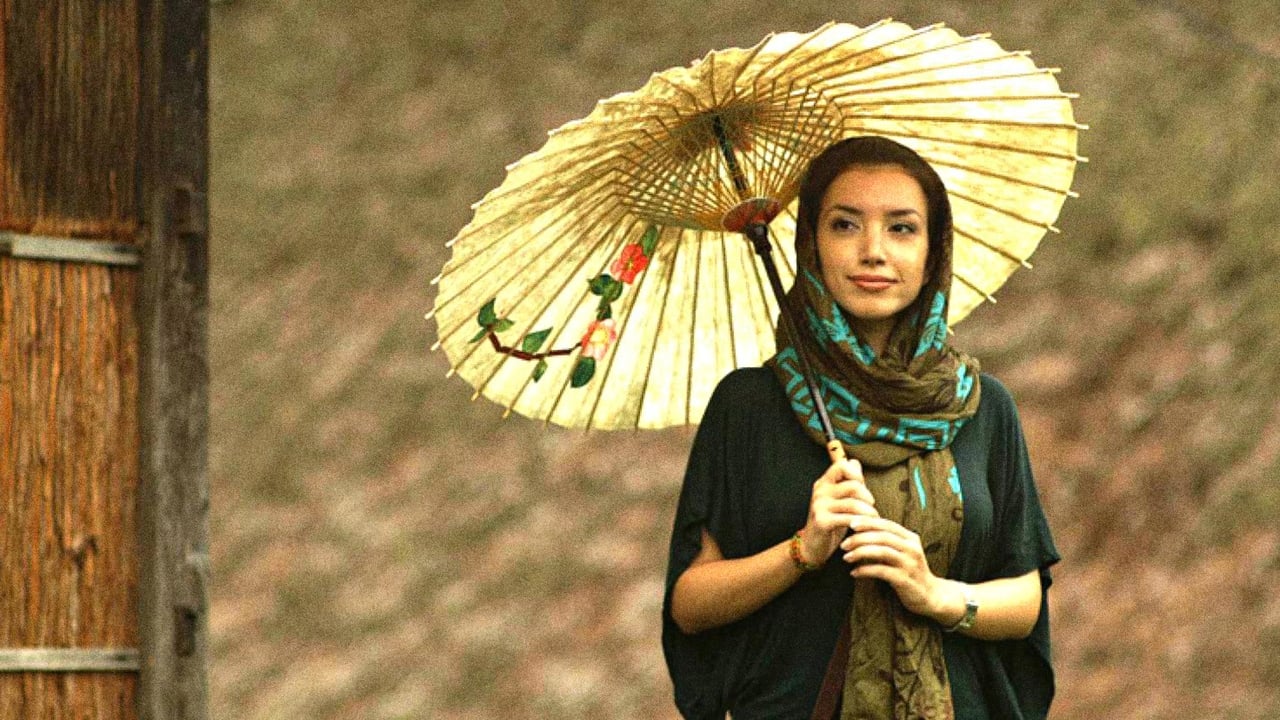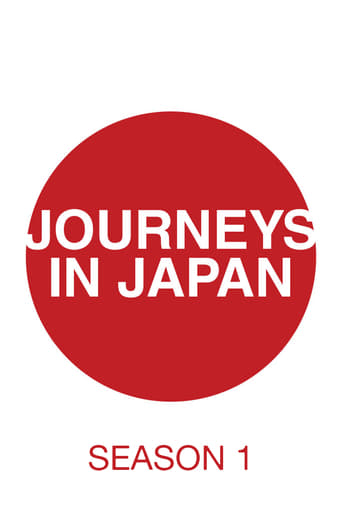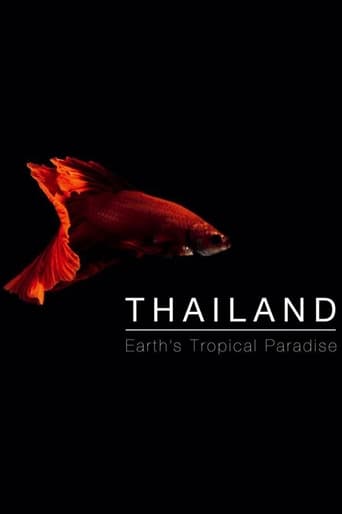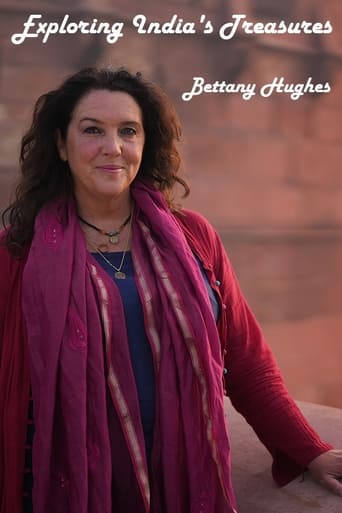Journeys in Japan Season 9
Journeys in Japan provides an eye-opening look at the many unique places to visit in Japan. English-speaking visitors travel the length of the country, exploring the culture, meeting the local people, visiting historic sites and offering travel hints rarely found in guidebooks.
With 30 Day Free Trial!
Journeys in Japan
2010 / TV-GJourneys in Japan provides an eye-opening look at the many unique places to visit in Japan. English-speaking visitors travel the length of the country, exploring the culture, meeting the local people, visiting historic sites and offering travel hints rarely found in guidebooks.
Watch Trailer
Journeys in Japan Season 9 Full Episode Guide
Iriomote is 2,000 kilometers southwest of Tokyo in an ocean of corals. The subtropical island enjoys year-round temperature of over twenty degrees Celsius. With ninety percent of the land blanketed in rain forest, it's a popular destination for outdoor pursuits. On Journeys in Japan, Kyle Card visits Iriomote to take in not only the natural splendors but also to witness a unique, 500-year-old festival called Shichi. He discovers a way of life, on this remote island, where locals live close to the land and benefit from its blessings.
Kanazawa City in Ishikawa Prefecture developed as a castle town of the Kaga Domain under the Maeda Clan's rule. For about 300 years from the late 16th century onward, the powerful feudal lords encouraged the arts, resulting in gorgeous landscape gardening, gold leaf and other crafts. On this edition of Journeys in Japan, TV personality Leina Bambino explores Kanazawa's deep culture through its colors.
The Houki-cho district lies in the west of Tottori Prefecture close to the foot of volcanic Mt. Daisen. It has a population of around 11,000, most of whom live from farming and rearing cattle. The town lies on an ancient trail once used by the pilgrims who made their way to Izumo Shrine, one of the most venerated Shinto sites in Japan. Because of this proximity, ancient legends of the gods have been kept alive in Houki-cho. Once a year, in October, the local people gather to conduct a traditional ritual that has been passed down through countless generations. The ritual has its roots in an ancient legend that the deity worshipped at the shrine was saved from a shipwreck by octopuses. On this edition of Journeys in Japan, John Daub from the US visits Houki-cho, samples the local specialties and meets the local people who are keeping the old ways alive.
Fukuoka, the largest city in southern Japan, was a merchant town in ancient times that prospered with foreign trade. It gained two distinctive features in the dawn of the Edo Period (1603 – 1868), when a special district for samurai warriors was established next to the time-honored merchant town. Fukuoka has since nurtured and passed down their respective cultures. Today, you can glimpse such inheritances in amazing spinning top performances and yabusame, the art of mounted archery.
Mount Gozaisho is a popular tourist destination located on the border of Mie and Shiga prefectures, and easily accessible by car from Nagoya. It's famous for its outdoor activities. Michael Keida from the United States gets the thrill of a lifetime, and a hard workout, as a guide takes him up waterfalls, sheer rock faces and through deep gorges and chimneys. He unwinds with good company over great meals… and time spent in the hot springs.
Kitayama Village lies deep in the mountains of the Kii Peninsula in central Japan. It is a small village, with a population of about 450. Some 97 percent of its area is covered with thick forest. In the old days, the main industry was forestry, and the lumber cut in the mountains used to be transported to the coast by assembling the logs into rafts and floating them downstream on the Kitayama River. Around 40 years ago, the village decided to revive that tradition and offer tourists the opportunity to ride down through the rapids on similar log rafts. The local specialty is a variety of citrus known as jabara, which only grows in the valley around Kitayama Village. On this edition of Journeys in Japan, DJ George Cockle visits Kitayama Village to find out what makes this small mountain village so unique.
The Seto Inland Sea in western Japan has been a major sea route since ancient times. The Geiyo Archipelago, of large and small islands, crisscrosses the inland sea between Hiroshima and Ehime Prefectures. The mighty Murakami pirates' base ruled these waters from the 14th to 16th centuries. In times of civil war, they allied with warlords using their military might, helping shape history. The primary objective of their activity was not looting, but maintaining order by guaranteeing safe passage of ships for a fee. They even engaged in trade with foreign countries. Tatsumasa Murasame, who is originally from Sweden but has assumed Japanese citizenship, visits the Geiyo Islands to trace this little known chapter of history. And he discovers the people's feelings of awe for the pirates, which have been passed down through the generations.
The island of Iki lies off the coast of Kyushu, facing out towards the Korean Peninsula. In ancient times, Iki was an important crossroads for international exchanges. These days the island is a modest paradise of unspoiled nature, with beautiful beaches, gentle landscapes and excellent seafood. Just an hour away from Fukuoka by high-speed ferry, it makes an ideal tourist get-away. On this edition of Journeys in Japan, Mai Rapsh explores Iki and meets some of the people who are keeping its traditional charm alive for future generations.
Totsukawa, in southern Nara Prefecture, is nestled deep in the mountains. The village's isolation from most of Japan for centuries has contributed to the preservation of many unique, old traditions and customs. Among them is the Oo-Odori dance, which is performed during the summer Bon festival when people welcome back the spirits of their ancestors. The Oo-Odori dance movements and music accompaniment remain unchanged from hundreds of years ago. Winnie Hsu visits Totsukawa to join its residents in the dance. She also experiences farm life when she stays at a farming family's inn. Of course, she also enjoys the natural beauty of Totsukawa, which spreads out along the Kumano River. Through her journey, Winnie discovers how deeply Japanese people are connected with their ancestors and ancestral homes.
Okushiri Island-about 84 kilometers in circumference-is located southwest of Hokkaido in remarkably blue and transparent waters. The island has rare rock formations shaped over many, many years, beech forests dating back more than 100 years, and unspoiled nature. In summer, many visitors come for tasting fruit-of-the-sea delicacies, such as freshly collected sea urchin and abalone. In 1993, the island suffered damage from a tsunami triggered by a massive earthquake. But the island has recovered. People are dedicated in their efforts to pass on the lessons from the disaster to future generations.
Kita-Akita City lies in the north of Akita Prefecture. It is a land of mountains and thick forests. The Akita Nairiku Line runs north-south through this wild terrain. On this edition of Journeys in Japan, Michael Keida visits two areas that can be accessed along this railroad. Since ancient times, there has been a long tradition of hunting in the Ani district. Known in Japanese as matagi, these hunters developed their own language and customs, many of which have been passed down to the present day. Michael meets a modern-day matagi, and learns how these hunters continue to live in harmony with the forests and the animals there. In the Takanosu district, an annual festival is held, in which gigantic drums are played to pray for rain and abundant harvests. On this edition of Journeys in Japan, Michael meets the people of Kita-Akita, and joins them in celebrating their close connection with the natural environment.
Mt. Fuji is the most famous peak in Japan. It is also a place of worship, and for centuries pilgrims have made their way to the summit as part of their spiritual practices. That is why Mt. Fuji has been registered by UNESCO as a World Cultural Heritage site. There are several trails leading to the top. Nowadays, most climbers start their ascent about halfway up, from the one of the 5th stations, which can be accessed by car or bus. But in the old days people used to spend many days on the climb, starting from sea level. On this edition of Journeys in Japan, Peter Skov traces the route of the ascetic monks and other pilgrims, following an ancient trail from the seashore at the very foot of Mt. Fuji, up to its very highest point.
Yuki (in Ibaraki Prefecture) and neighboring Oyama (Tochigi Prefecture) are famous throughout Japan as the home of traditional hand-made textiles known as yuki-tsumugi. The techniques for producing the yarn, dyeing it and weaving the fabric date back to ancient times and are unique in Japan. In the old days, Yuki flourished as a castle town, and many stores and warehouses that were used by the textile wholesalers remain to this day. Meanwhile, Oyama was known for culturing the silkworms that produce the raw silk used for yuki-tsumugi. Leina Bambino meets with some of the artisans in Yuki who produce textiles. In Oyama, she also visits farmers who grow the local specialty, bottle gourds (kanpyo), which are in peak season from late June through August. On this edition of Journeys in Japan: meeting the families - the artisans and food producers - who are working to pass down their skills for future generations.
The island of Tobishima lies off the coast of Yamagata Prefecture in the Sea of Japan. It is about 10 kilometers in circumference, and is dotted with long-established fishing villages. These days, it has a population of about 200 people. Tobishima is a port of call for migratory birds and an important breeding ground for black-tailed gulls. Its rich natural environment attracts many anglers and birdwatchers. In 2016 Tobishima was designated as a geopark by the Japan Geopark Committee. On this episode of Journeys in Japan, John Moore explores Tobishima, meets the people living here, and learns about their self-sufficient lifestyle.
The town of Misugi is located deep in the mountains of Mie Prefecture, central Japan. 90% of the town is covered with forests, and forestry is the leading industry. Michael Keida from the United States experiences "forest therapy", which is a scientifically proven method for improving body and mind wellness through woodland walking. He experiences logging firsthand, and learns how to forage for wild edible plants and prepare them in cooking. Michael also meets locals who are committed to preserving the age-old community, and others who have relocated to the area.
Tiny Ojika is part of the Goto Islands of Nagasaki Prefecture, which lies one thousand kilometers west of Tokyo. The population is approximately 2,500. There are only two traffic lights on the island and no convenience stores or large tourist facilities. The back streets offer a glimpse of old Japan. Ojika once thrived as a fishing base of the East China Sea, when over 10,000 people resided on the island. That was around 60 years ago, though, and with the decline of the fishing industry people moved to the mainland for jobs, leading to a sharp drop in the population. Recently, however, a change is occurring here. Increasingly people are moving to Ojika. What is it that they have found in Ojika? A charming place of natural beauty, tradition, community spirit and all at an unhurried pace. In this edition of Journeys in Japan, American translator B.T. travels to Ojika Island. He discovers the island's appeal through interacting with the locals.
One hundred drawings portray the customs and scenery of 150 years ago. These scenes are still remarkably visible in the old castle town of Tsuwano, Shimane prefecture. In this episode of Journeys in Japan, Australian actor Luke Bridgford uses the ancient Tsuwano drawings as a map to the town's past, present and future.
The Tsugaru area of Aomori Prefecture has long been known as one of Japan's top districts for developing sumo wrestlers. Since the first national sumo arena opened in 1909 in Tokyo's Ryogoku district, the 69 wrestlers from the prefecture have reached the top division - more than any other area of Japan. There are a number of reasons for this. In winter, Tsugaru receives heavy snowfalls, so people tend to focus on indoor sports, such as sumo. At the same time, the people of Tsugaru are noted for their patience and perseverance, qualities that are prized in sumo. On this episode of Journeys in Japan, American translator B.T travels to the Tsugaru area to watch young sumo wrestlers in action. He is shown around a museum that celebrates the local people's passion for the sport. He also takes in the majestic view from the top of Mt. Iwaki, and visits a museum exhibiting gigantic neputa festival floats.
Nikko, which is a leading tourist destination in Japan, has long been venerated as a sacred place of mountain worship. It is home to the mausoleum of Tokugawa Ieyasu, who unified Japan and founded the Tokugawa Shogunate in the beginning of the 17th century. In the mid-19th century, after a period of isolation, Japan resumed international relations. Nikko soon became one of the most sought after summer playgrounds for Westerners due to its abundant nature and cool climate. On this edition of Journeys in Japan we explore architectural jewels that quietly reveal Nikko's history, including the Nikko Toshogu Shrine where Tokugawa Ieyasu is enshrined, former villas of foreign embassies, and a classic hotel.
Atami, in Shizuoka prefecture, is one of Japan's leading hot spring resorts and is only 45 minutes from Tokyo. The city, which has been a resort for hundreds of years, has seen hard times. Tourism was down from the 1990s to 2011. However, in recent years it has been showing miraculous recovery, and the city is regaining its vibrancy. On Journeys in Japan, American actor Charles Glover gets a sense of Atami through its enterprising residents-some running veteran establishments and others turning to innovation to secure their future. He experiences, and shares, why Atami continues to delight visitors.
In the old days, the cities of Ashikaga and Tochigi were post towns along the highway that led to the famous Nikko Toshogu Shrine, where the first Tokugawa shogun was buried. Pilgrims used to make their way along this highway, as did Imperial court messengers from Kyoto. The cities also prospered thanks to their riverside locations. Lumber and other merchandise was shipped downstream and there was a busy trade with merchants in Edo (modern-day Tokyo). Ashikaga boasts renowned tourist sites, including the Ashikaga Gakko, the oldest school in Japan. And the Ashikaga Flower Park draws visitors from far and wide to see the remarkable display of wisteria blossom. On this edition of Journeys in Japan, Leina Bambino visits these two cities where people continue to live with tradition, while preserving the natural environment and creating new attractions.
The Agano River flows through northern Niigata Prefecture, about 200 kilometers to the north of Tokyo. It runs from snow-covered mountains down to the sea, and in the old days it formed an important artery for transportation. On this edition of Journeys in Japan, photographer and haiku poet Kit Pancoast Nagamura meets the people living alongside the river and observes how they mark the arrival of spring.
Only 50 kilometers away from the capital the mountainous area offers historic scenery and gentle trekking courses. Local residents are passionate about preserving their old townscapes, dating back several hundred years, and promoting awareness of their natural environment through eco-tours. On Journeys in Japan, China-born mountaineering guide Haiyan Huang enjoys spring foraging for sansai wild edible plants, as well as taking in temples and architecture on Okumusashi's gentle hiking routes.
The distinctive style of pottery known as Oribe ware made its appearance in Japan towards the end of the 16th century. With its uneven, misshapen appearance, bold colors and eccentric designs, it was an astonishing new style - and one that still seems modern and appealing today. The origins of this pottery are attributed to the samurai warlord Furuta Oribe. Born at a time when Japan was riven by civil war, he became a leading tea master and aesthete. On this edition of Journeys in Japan, David Wells travels to Kyoto, Gifu and Osaka, tracing the lifeline of Furuta Oribe to discover the roots of Oribe ware.
Kombu (kelp) seaweed has been an essential ingredient in the Japanese diet for over a thousand years. It is used to make the savory dashi stock that underpins all Japanese cuisine. It also cooked in many dishes to add essential minerals and umami. This kombu seaweed grows in the sea around Hokkaido. In the old days, trading vessels known as kitamae-bune used to carry kombu from Hokkaido to other parts of Japan, traveling down the Japan Sea coast. Toyama was one of the ports of call for those ships, and the kitamae-bune merchants became very wealthy. At the same time, kombu became embedded in the lives and daily food of the local people. These days, people in Toyama use more of the seaweed in their local cuisine than almost anywhere else in Japan. On this edition of Journeys in Japan, Mai Rapsch from Germany visits Toyama to explore its rich food culture and traditions.
The charming old castle town of Makabe is located in the foothills of Mt. Tsukuba, not far from Tokyo. It flourished as a regional cultural and industrial center from the Edo through Taisho periods. About 300 traditional storefronts, warehouses, and gates remain, as well as the original street plan from 400 years ago. The Makabe Denshokan, a former guardhouse, now houses a historical museum. Pick up a map there and stroll around town to take in the buildings registered as cultural assets. The Hina-matsuri (Hina Doll Festival) in Makabe is held annually from the beginning of February to early March. The old stores, and some homes, share their elaborate doll displays with visitors.
In Hachinohe city, on the eastern coast of Aomori Prefecture, nature has not always been kind to the people. Rice cultivation has traditionally been difficult in the region due to chilly seasonal winds-called yamase - during the late spring and summer. In the past, residents suffered numerous hardships, including frequent famines. Yet it is this very climate that gave birth to Enburi, which is a ritual folk dance to pray for abundant crops. It's believed that the traditional dance dates back 800 years. Michael Keida from the United States visits Hachinohe to experience how the local people have endured the long, severe winters. He also meets groups of people who work hard to keep their Enburi tradition alive.
Every year from February to March, ice floes from Russia's Amur River float across the Okhotsk Sea to the shores of eastern Hokkaido, packing against the shoreline. On this edition of Journeys in Japan, Roman Markovtsev from Russia explores this frozen coast and experiences the winter wonderland of ice, both above and below the surface. He joins fishermen who fish in the traditional way on a frozen lake. And he meets with local people who have taken up the sport of curling in a big way.
Joetsu City in Niigata Prefecture is famous for its harsh winters and heavy snowfalls. Since the Edo Period (1603-1868), people here have built covered arcades known as gangi along their streets. One place that's famous for these gangi is Takada. On this edition of Journeys in Japan, Kyle Card explores the Takada area and meets the people living there, to find out how they feel about their distinctive traditional townscape.
Fukuoka is the largest city in southern Japan, and the political and economic hub for all of Kyushu. For more than a thousand years, Fukuoka has had strong links with the Asian mainland, through the port of Hakata. The city is also famous for its rich culinary culture, especially its yatai (street stalls). Each night about 100 of these yatai are set up in three parts of the city. Not only do they serve good, tasty food, they offer a fun, relaxing environment for customers. They are very popular, attracting people from all around Japan and from abroad. On this edition of Journeys in Japan, chef David Wells explores the area around Fukuoka City to discover the local flavors. He also meets with people with a deep knowledge of the region's food culture and history.
Oita Prefecture in Kyushu is one of Japan's best known places for onsen - or hot springs. The city of Beppu is especially famous for its numerous hot spring sources and the volume of hot water - and it attracts many tourists. Marie Krause is from Aachen, in Germany, which is also famous as a resort with many hot springs. On this edition of Journeys in Japan, Marie visits Beppu to discover the many different kinds of hot springs in the city. And she enjoys Japan's traditional onsen culture to its fullest.
The Northern Alps, which has many mountains over 3,000-meters in height, is located in central Japan. It attracts many mountaineers even in harsh winter when it's covered in snow and ice. The operator of a mountain lodge on Tsubakuro-dake in western Nagano hosts traditional events from year-end to New Year. Mountaineering enthusiasts climb up to the lodge to take part in the New Year countdown and mochitsuki rice pounding on the first day of the year. Later they make an offering of a buri yellowtail at the summit to pray for safety throughout the year. On Journeys in Japan, mountain guide Huang Haiyan scales Tsubakuro-dake via the secluded Nakabusa hot springs. She immerses herself in the breathtaking scenery, camaraderie of fellow-hikers, and New Year's rituals.
On this journey, we visit Yokkaichi in northern Mie, central Japan. This industrial city, with a population of just over 300,000, is home to Japan's first petrochemical complex. It's known as the place where air pollution from sulfurous acid gas emissions caused respiratory diseases, called "Yokkaichi asthma," in the 1960s. Thanks to sweeping environmental protection measures, the environment has been vastly cleaned up, and the petrochemical complex has become a source of tourism-especially its nighttime factory cruises. The city is also famous for its ceramic ware, called Banko-yaki. Some local studios offer pottery-making workshops. Visitors can also take in the tea fields that flank the city's edge and enjoy high-quality beverage in a cafe run by a tea-farming family. Journalist Alice Gordenker travels to Yokkaichi, a city that has recovered from air pollution.
Hiroshima is home to two World Heritage Sites, the Atomic Bomb Dome and Miyajima Island. Other buildings of architectural significance can be found in, and around, the city. Tokyo-based architect James Lambiasi explores the history of Hiroshima-and the nearby areas of Onomichi and Iwakuni-through iconic architectural sites, as well as simple, old dwellings.
Free Trial Channels
Seasons


































